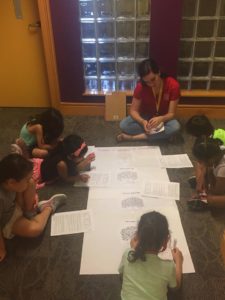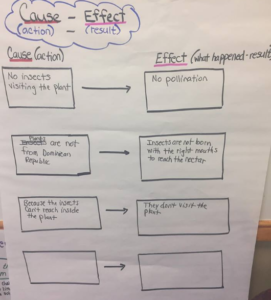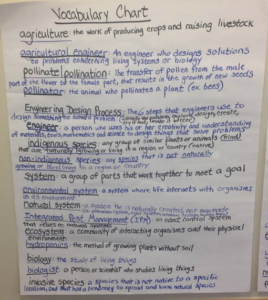Summer SAVY 2018: Session 3, Day 2 – Engineering Solutions (Rising 1st)
Posted by morganr1 on Tuesday, June 26, 2018 in Grade 1, SAVY.
Wow! We had another great day of hands on investigations, and making meaning out of what we observed as well as how the learning can be applied to solving agricultural engineering problems. Students were excited to share what they found in their home environment from the natural pollination system, so they shared their evidence with each other. Mrs. Janette and I were intentionally helping students connect their share items to the natural pollination system as students presented what they brought. Of course, we had to get out our hand lenses and microscopes to look more closely at our evidence of the parts of the natural pollination system!
This course is rich with new vocabulary, so before we dove into reading more from our book, Mariana Becomes a Butterfly, we discussed the following vocabulary: agriculture, agricultural engineer, Integrated Pest Management (IPM), indigenous species and non-indigenous species, invasive species, and harmful insects. Yesterday, students were asked to think about the following question: “All harmful insects be killed.” Then each student placed their name on a sticky note and placed it on one of two sides: “I agree or I disagree”. Students will re-visit this question on Friday and change their original selection or keep it in the same category. As we began reading the next chapters from our book, Mariana Becomes a Butterfly, students asked and answered questions about the problem of the plant that had been relocated from Hawaii to the Dominican Republic that was not pollinating anymore. I also showed the class what the real ohelo berry plant looks like as well as what the Dominican Republic looks like. We discussed what an island is. We created a cause and effect chart to explain the reasons for the problems that needed to be solved. Students also identified the agricultural engineering problem that Mariana needed to solve using the engineering process.
Students added more to the cause and effect natural pollination system chart after doing a small group activity that involved acting out a play about real world problems and solutions that occurred on an apple farm. These activities and investigations are all leading to our engineering problem-solution natural pollination system project! After this discussion, students learned more about harmful insects and the implications and consequences of using pesticides to control harmful insects verses IPM solutions to these real world problems (natural system solutions with beneficial insects). Students really enjoyed acting out the problems and solutions, and they also gained a greater appreciation for the work of Integrated Pest Management through the work of agricultural engineers.
We ended our session watching some information from agricultural engineers regarding beneficial and non-beneficial insects in agriculture and in our home gardens! Students are prepared to tell you names of some of the non-beneficial insects as well as the beneficial insects (they especially know the name of the top beneficial insect! If you have time at dinner, here is great question to discuss with your student tonight: What are the parts of the natural pollination system and how do the parts help each other? Another topic you could discuss is to ask your child what designs they are thinking of for their hand pollination model!
Tomorrow will be another fabulous day, just as it was today! Can’t wait to see the models our engineers create to test!
Sincerely,
Ms. Tyson
Our Play Helped us Utilize Our Vocabulary Words and Understand Cause and Effect




